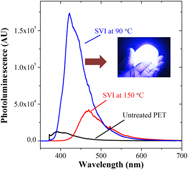Crossref Citations
This article has been cited by the following publications. This list is generated based on data provided by
Crossref.
Akyildiz, Halil I.
Mousa, Moataz Bellah M.
and
Jur, Jesse S.
2015.
Atmospheric pressure synthesis of photoluminescent hybrid materials by sequential organometallic vapor infiltration into polyethylene terephthalate fibers.
Journal of Applied Physics,
Vol. 117,
Issue. 4,
Akyildiz, Halil I.
and
Jur, Jesse S.
2015.
Organometallic exposure dependence on organic–inorganic hybrid material formation in polyethylene terephthalate and polyamide 6 polymer fibers.
Journal of Vacuum Science & Technology A: Vacuum, Surfaces, and Films,
Vol. 33,
Issue. 2,
Halbur, Jonathan C.
Padbury, Richard P.
and
Jur, Jesse S.
2016.
Silver decorated polymer supported semiconductor thin films by UV aided metalized laser printing.
Journal of Vacuum Science & Technology A: Vacuum, Surfaces, and Films,
Vol. 34,
Issue. 3,
Akyildiz, Halil I.
Stano, Kelly L.
Roberts, Adam T.
Everitt, Henry O.
and
Jur, Jesse S.
2016.
Photoluminescence Mechanism and Photocatalytic Activity of Organic–Inorganic Hybrid Materials Formed by Sequential Vapor Infiltration.
Langmuir,
Vol. 32,
Issue. 17,
p.
4289.
Obuchovsky, Stas
Frankenstein, Hadar
Vinokur, Jane
Hailey, Anna K.
Loo, Yueh-Lin
and
Frey, Gitti L.
2016.
Mechanism of Metal Oxide Deposition from Atomic Layer Deposition inside Nonreactive Polymer Matrices: Effects of Polymer Crystallinity and Temperature.
Chemistry of Materials,
Vol. 28,
Issue. 8,
p.
2668.
Dazzi, Alexandre
and
Prater, Craig B.
2017.
AFM-IR: Technology and Applications in Nanoscale Infrared Spectroscopy and Chemical Imaging.
Chemical Reviews,
Vol. 117,
Issue. 7,
p.
5146.
Leng, Collen Z.
and
Losego, Mark D.
2017.
Vapor phase infiltration (VPI) for transforming polymers into organic–inorganic hybrid materials: a critical review of current progress and future challenges.
Materials Horizons,
Vol. 4,
Issue. 5,
p.
747.
Leng, Collen Z.
and
Losego, Mark D.
2018.
A physiochemical processing kinetics model for the vapor phase infiltration of polymers: measuring the energetics of precursor-polymer sorption, diffusion, and reaction.
Physical Chemistry Chemical Physics,
Vol. 20,
Issue. 33,
p.
21506.
Zhang, Junyan
Song, Yongxin
and
Li, Dongqing
2018.
Electrokinetic motion of a spherical polystyrene particle at a liquid-fluid interface.
Journal of Colloid and Interface Science,
Vol. 509,
Issue. ,
p.
432.
Azpitarte, Itxasne
and
Knez, Mato
2018.
Vapor phase infiltration: from a bioinspired process to technologic application, a prospective review.
MRS Communications,
Vol. 8,
Issue. 3,
p.
727.
Kochan, Kamila
Perez-Guaita, David
Pissang, Julia
Jiang, Jhih-Hang
Peleg, Anton Y.
McNaughton, Don
Heraud, Philip
and
Wood, Bayden R.
2018.
In vivo
atomic force microscopy–infrared spectroscopy of bacteria
.
Journal of The Royal Society Interface,
Vol. 15,
Issue. 140,
p.
20180115.
Waldman, Ruben Z.
Choudhury, Devika
Mandia, David J.
Elam, Jeffrey W.
Nealey, Paul F.
Martinson, Alex B. F.
and
Darling, Seth B.
2019.
Sequential Infiltration Synthesis of Al2O3 in Polyethersulfone Membranes.
JOM,
Vol. 71,
Issue. 1,
p.
212.
Subramanian, Ashwanth
Tiwale, Nikhil
and
Nam, Chang-Yong
2019.
Review of Recent Advances in Applications of Vapor-Phase Material Infiltration Based on Atomic Layer Deposition.
JOM,
Vol. 71,
Issue. 1,
p.
185.
Losego, Mark D.
and
Peng, Qing
2019.
Surface Modification of Polymers.
p.
135.
Subramanian, Ashwanth
Doerk, Gregory
Kisslinger, Kim
Yi, Daniel H.
Grubbs, Robert B.
and
Nam, Chang-Yong
2019.
Three-dimensional electroactive ZnO nanomesh directly derived from hierarchically self-assembled block copolymer thin films.
Nanoscale,
Vol. 11,
Issue. 19,
p.
9533.
Ingram, Wade F.
and
Jur, Jesse S.
2019.
Properties and Applications of Vapor Infiltration into Polymeric Substrates.
JOM,
Vol. 71,
Issue. 1,
p.
238.
McGuinness, Emily K.
Leng, Collen Z.
and
Losego, Mark D.
2020.
Increased Chemical Stability of Vapor-Phase Infiltrated AlOx–Poly(methyl methacrylate) Hybrid Materials.
ACS Applied Polymer Materials,
Vol. 2,
Issue. 3,
p.
1335.
Subramanian, Ashwanth
Tiwale, Nikhil
Doerk, Gregory
Kisslinger, Kim
and
Nam, Chang-Yong
2020.
Enhanced Hybridization and Nanopatterning via Heated Liquid-Phase Infiltration into Self-Assembled Block Copolymer Thin Films.
ACS Applied Materials & Interfaces,
Vol. 12,
Issue. 1,
p.
1444.
Kim, Seung Hun
Song, Seung Yong
Kim, Soo Youn
Chang, Moon Won
Kwon, Hyo Jeong
Sung, Myung Mo
and
Chu, Hye Yong
2020.
84‐4: New Barrier Fabrication Method based on an Infiltration Technology for Flexible OLED Displays.
SID Symposium Digest of Technical Papers,
Vol. 51,
Issue. 1,
p.
1273.
Ren, Yi
McGuinness, Emily K.
Huang, Chaofan
Joseph, V. Roshan
Lively, Ryan P.
and
Losego, Mark D.
2021.
Reaction–Diffusion Transport Model to Predict Precursor Uptake and Spatial Distribution in Vapor-Phase Infiltration Processes.
Chemistry of Materials,
Vol. 33,
Issue. 13,
p.
5210.
